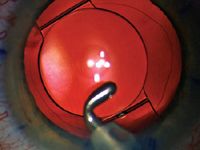Article
Accommodating intraocular lens platform offers benefits for presbyopic correction
An accommodating IOL offers excellent depth of focus and quality of vision with reduced dependence on glasses.

"For patients wanting presbyopic correction with a higher quality of vision, the [lens] is a better choice than a multifocal IOL, and unlike multifocal IOLs, [it] can be implanted in any eye where one would implant an aspheric or spherical monofocal IOL, including in the presence of glaucoma, age-related macular degeneration, prior RK, or Fuchs' dystrophy," said Dr. Lindstrom, founder and attending surgeon, Minnesota Eye Consultants, Minneapolis.
"However, patients must be educated that they might need to wear glasses occasionally for near vision tasks with the [lens] implanted," he added.

"As the pupil constricts in reaction to bright light and accommodation for reading, there is a myopic shift in power of the Crystalens HD of [about] –0.50 D that enhances reading, whereas when the pupil enlarges at night, the Crystalens HD refraction shifts in the hyperopic direction toward plano," Dr. Lindstrom said.
"With the Crystalens 5-0, there was a hyperopic shift in power as the pupil got smaller, and this difference explains why near acuity outcomes are better with the Crystalens HD," he said.
The quality-of-vision advantage of the Crystalens HD was seen in a study of modulation transfer function, where it exhibited a performance benefit over multifocal IOLs with testing at a 3-mm aperture, although the difference between lenses diminished at a 6-mm aperture.
"There was a concern that with power added centrally, the Crystalens HD would be associated with loss of quality of vision at distance," Dr. Lindstrom said.
"However, if anything, there is a gain in mesopic contrast sensitivity testing both with and without glare. The reason is that because although the Crystalens HD has a blended bispheric monofocal optic, it behaves similar to an aspheric monofocal lens," Dr. Lindstrom said. "It is well known that an aspheric design has a quality-of-vision benefit in a mesopic environment, and this was confirmed in clinical trials."
The lens also provides good intermediate vision, surpassing the ReZoom multifocal IOL (Abbott Medical Optics [AMO]), AcrySof ReSTOR 4.0 multifocal IOL (Alcon Laboratories), and the Tecnis diffractive multifocal IOL (AMO) based on analysis of data from the SurgiVision DataLink database.
"This benefit of the Crystalens HD is expected considering its add power is lower than that of the multifocal IOLs," Dr. Lindstrom said.
"Because it provides a good range of functional uncorrected visual acuity, the Crystalens HD has attracted many surgeons who previously favored the other multifocal IOLs among presbyopia-correcting implants, and it has become a popular choice among surgeons who do custom matching," he added. "Using the Crystalens HD combined with a diffractive multifocal IOL-either the ReSTOR or Tecnis-works well and makes good sense optically."
Newsletter
Don’t miss out—get Ophthalmology Times updates on the latest clinical advancements and expert interviews, straight to your inbox.




